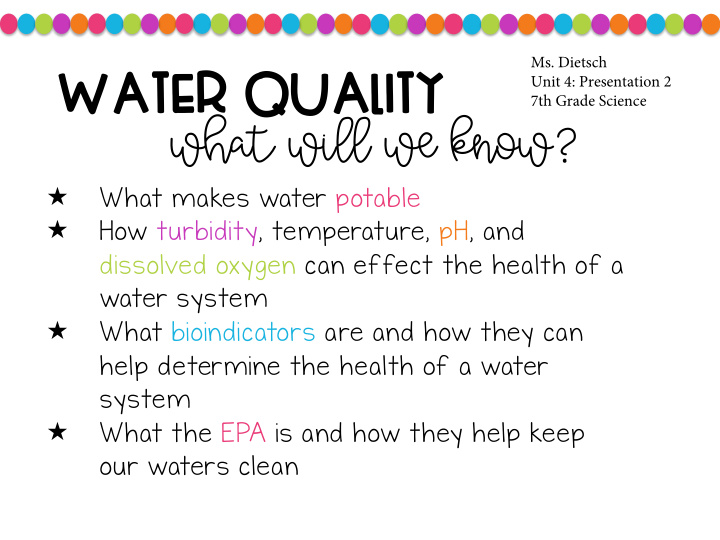



7th Grade Science Unit 4: Presentation 2 Ms. Dietsch WATER QUALITY what will we know? « What makes water potable « How turbidity, temperature, pH, and dissolved oxygen can effect the health of a water system « What bioindicators are and how they can help determine the health of a water system « What the EPA is and how they help keep our waters clean
WATER SYSTEM HEALTH what effects it? « When it comes to the health of a water system, there are many factors that go into it. The balance between physical, chemical and biological variables determines the health of a water system PHYSICAL CHEMICAL BIOLOGICAL These variables are subject to - Temperature - Dissolved - Fish change from - Turbidity oxygen (+ - Algae both natural - Water other gases) - Insects and man-made Movement - pH - Plants forces - Nitrates - Salinity
WATER SYSTEM HEALTH why do we care? « Freshwater is a major concern because it is the source of water for humans and animals « Our freshwater that we use can be classified as SAFE or POTABLE HEALTHY ENOUGH TO BATHE vs. IN AND CLEAN WITH HEALTHY ENOUGH TO DRINK
PHYSICAL INDICATORS temperature « The temperature of a body of water determines the organisms that can live BETTER there FOR « Many organisms have a preferred AQUATIC LIFE! temperature range where they will thrive « THINK ABOUT IT! Can we live in -50o weather but SOME CAN! « As the temperature increases: « It is able to dissolve more sediment which can block light and not allow photosynthesis to occur « It dissolves LESS oxygen (because particles are moving too fast and O2 can escape into the air) and may not contain enough for organisms to survive
PHYSICAL INDICATORS turbidity « Turbidity is how clear/cloudy a body of water is « Cloudiness is due to the amount of sediment dissolved in the water « A HIGH turbidity = not potable « Can lead to increased temperatures, decreased DO, and impairment of some aquatic organisms MOST POTABLE! HIGH TURBIDITY LOW TURBIDITY (CLOUDY) (Clear)
CHEMICAL INDICATORS dissolved oxygen « Dissolved oxygen is the amount of oxygen in water that is available for aquatic organisms to use « The level of oxygen in surface water is important for many organisms such as zooplankton and fish to thrive « There are two ways oxygen gets into the water: 1. From the AIR (being trapped by waves and moving currents) 2. From PLANTS releasing O 2 during photosynthesis
CHEMICAL INDICATORS pH level « The pH of a body of water determines how acidic or how basic it is « pH is measured on a scale from 0-14 o 0-6: ACIDIC o 7: NEUTRAL o 8-14: BASIC (Alkaline) « The pH of water is known to have a synergistic effect, which means that materials (iron, aluminum, ammonia, mercury) introduced into bodies of water can have more or less of an impact based on the pH of the water q EXAMPLE: Metals in more acidic water can become more dangerous or poisonous than they normally would be in neutral water
CHEMICAL INDICATORS nitrates + phosphates « Nitrates and phosphates come from Nitrogen and Phosphorous, which are essential nutrients for healthy plant growth. « Too many nitrates or phosphates in drinking water can make it unhealthy SOURCES OF NITRATES SOURCES OF PHOSPHATES - Runoff contaminated - Human and animal with fertilizers waste - Septic tank leaks - Laundry - Sewage - Cleaning and industrial waste
CHEMICAL INDICATORS salinity « Salinity is the measure of salt in water and can be an indicator of how healthy a water system is « Salinity can enter water systems through natural processes of weathering rocks from wind and rain « High concentrations of salinity can cause vegetation to become unhealthy or die and can lead to a decrease in biodiversity AMOUNT OF DIFFERENT SPECIES LIVING IN AN AREA
BIOLOGICAL INDICATORS bioindicators « Biological indicators (Bioindicators) are macroinvertebrates that can give an indication of how healthy a water system is. « The presence and numbers of the types of fish, insects, algae, plants and other aquatic organisms can tell us how healthy the water they live in is « These organisms are usually easy to collect and identify « These organisms are used to measure water health because many are very sensitive to pollution. o Poor water quality is indicated by a few number of bioindicators organisms in one place
BIOLOGICAL INDICATORS bioindicators The species in the GREEN to the right is a bioindicator species because it is disturbance-intolerant (which means it does not handle a change in the water well). H - As the water withdrawal occurs, and the water system is less healthy for these organisms, their abundance numbers begin to drop.
WATER STEWARDSHIP protecting our water « There has only been a growing awareness and concern for water pollution for the past 45-50 years. Before that, there was little concern about what was being put or dumped into our water systems. « Part of this awareness came with the development of the Environmental Protection Agency (EPA) in 1970 « In 1972, the Clean Water Act established the regulations on putting pollutants into the water This gave the EPA the authority to test for pollutants and chemicals in the water and set maximum amounts allowed to be found in the water
WATER STEWARDSHIP before the epa The Cuyahoga River in Cleveland was so polluted with oils and chemicals that the water actually set fire! Q
WATER STEWARDSHIP after the epa Now you can swim in that same river! V
Recommend
More recommend